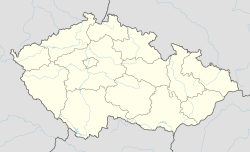바닐산
Vanillic acid| | |||
| 이름 | |||
|---|---|---|---|
| 우선 IUPAC 이름 4-히드록시-3-메톡시벤조산 | |||
| 기타 이름 4-히드록시-m-아니신산, 바닐레이트 | |||
| 식별자 | |||
3D 모델(JSmol) | |||
| 체비 | |||
| 첸블 | |||
| 켐스파이더 | |||
| ECHA 정보 카드 | 100.004.061 | ||
PubChem CID | |||
| 유니 | |||
CompTox 대시보드 (EPA ) | |||
| |||
| |||
| 특성. | |||
| C8H8O4 | |||
| 몰 질량 | 168.165 g/140−1 | ||
| 외모 | 흰색에서 연노란색 분말 또는 결정체 | ||
| 녹는점 | 210 ~ 213 °C (410 ~415 °F, 483 ~486 K) | ||
| 위험 요소 | |||
| NFPA 704(파이어 다이아몬드) | |||
| 관련 화합물 | |||
관련 화합물 | 바닐린, 바닐린 알코올 | ||
달리 명시되지 않은 한 표준 상태(25°C[77°F], 100kPa)의 재료에 대한 데이터가 제공됩니다. | |||
바닐산(4-히드록시-3-메톡시벤조산)은 향미제로 사용되는 디히드록시벤조산 유도체이다.그것은 바닐린의 산화 형태이다.페룰산으로부터 [2][3]바닐린을 생산하는 중간체이기도 하다.
자연발생
지금까지 알려진 식물 중 가장 많은 양의 바닐산은 중국 전통 의학에 사용되는 중국 토종 초본인 Angelica sinensis [4]뿌리에서 발견됩니다.
음식물의 발생
아사이 기름과,açaí 손바닥(에우테르페 oleracea)의 과일로부터 획득된 바닐산(1616±94 mg/kg)이 풍부하다.[5]그것은 아르간 오일 안의 주요 천연 페놀.[표창 필요한]또한 와인과 식초에서 발견된다.[6]
대사
Vanillic 산은 한명의 카테킨 대사 물질 인간의 녹차에 투입의 소비 후의.[7]
합성
바닐린의 카르본산 산화는 최대 88%의 [8]수율에서 일어났다.
레퍼런스
- ^ "Vanillic acid (4-hydroxy-3-methoxybenzoic acid)". chemicalland21.com. Retrieved 2009-01-28.
- ^ Lesage-Meessen L, Delattre M, Haon M, Thibault JF, Ceccaldi BC, Brunerie P, Asther M (October 1996). "A two-step bioconversion process for vanillin production from ferulic acid combining Aspergillus niger and Pycnoporus cinnabarinus". J. Biotechnol. 50 (2–3): 107–113. doi:10.1016/0168-1656(96)01552-0. PMID 8987621.
- ^ Civolani C, Barghini P, Roncetti AR, Ruzzi M, Schiesser A (June 2000). "Bioconversion of ferulic acid into vanillic acid by means of a vanillate-negative mutant of Pseudomonas fluorescens strain BF13". Appl. Environ. Microbiol. 66 (6): 2311–2317. doi:10.1128/AEM.66.6.2311-2317.2000. PMC 110519. PMID 10831404.
- ^ Duke, JA (1992). Handbook of phytochemical constituents of GRAS herbs and other economic plants. CRC Press, 999 edition. ISBN 978-0-8493-3865-6. Archived from the original on 2015-09-23. Retrieved 2012-01-07.
- ^ Pacheco-Palencia LA, Mertens-Talcott S, Talcott ST (Jun 2008). "Chemical composition, antioxidant properties, and thermal stability of a phytochemical enriched oil from Açaí (Euterpe oleracea Mart.)". J Agric Food Chem. 56 (12): 4631–4636. doi:10.1021/jf800161u. PMID 18522407.
- ^ Gálvez, Miguel Carrero; Barroso, Carmelo García; Pérez-Bustamante, Juan Antonio (1994). "Analysis of polyphenolic compounds of different vinegar samples". Zeitschrift für Lebensmittel-Untersuchung und -Forschung. 199: 29–31. doi:10.1007/BF01192948. S2CID 91784893.
- ^ Pietta, P. G.; Simonetti, P.; Gardana, C.; Brusamolino, A.; Morazzoni, P.; Bombardelli, E. (1998). "Catechin metabolites after intake of green tea infusions". BioFactors. 8 (1–2): 111–8. doi:10.1002/biof.5520080119. PMID 9699018. S2CID 37684286.
- ^ Lim M, Yoon CM, An G, Rhee H (2007). "Environmentally benign oxidation reaction of aldehydes to their corresponding carboxylic acids using Pd/C with NaBH4 and KOH". Tetrahedron Lett. 48 (22): 3835–3839. doi:10.1016/j.tetlet.2007.03.151.





